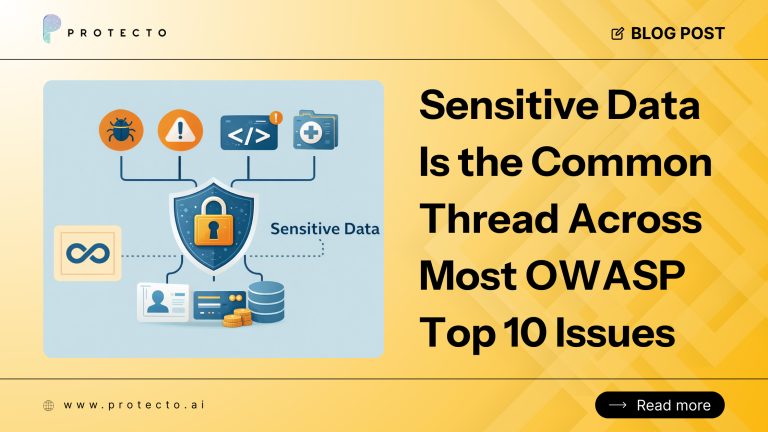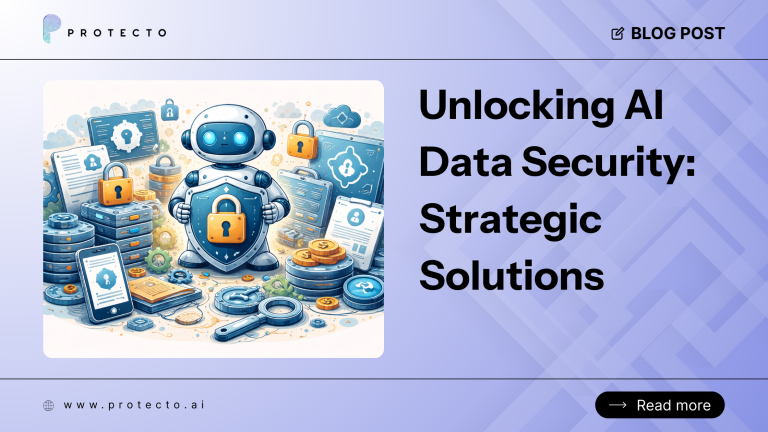The primary goal of the GDPR is to safeguard personal information by establishing stringent guidelines and policies for businesses handling Personally Identifiable Information (PII). Among the essential aspects of compliance is GDPR data mapping, a series of processes that empower organizations to gain a comprehensive understanding of data flows and the processing of individuals’ personal data (such as users or customers) throughout the organization.
To adhere to this regulation and ensure appropriate processing of personal data, organizations must have a firm grasp on all customer data and accurately map it. Traditional methods may prove challenging for this task, especially with the rapid growth and evolution of data collection and processing. As a result, organizations will need to adopt efficient data mapping tools to meet GDPR requirements effectively.
Achieving GDPR compliance can be a time-consuming endeavor for large organizations and a daunting process for small businesses with limited resources for software and consultants. To alleviate some of the burdens faced by companies striving to enhance their data privacy practices, here is a concise guide on where to begin. Implementing data mapping can significantly aid any business embarking on its GDPR journey, ensuring a smoother path to compliance.
What is Data Mapping
Data mapping is the process of connecting data elements or attributes from one data source to corresponding data elements in another data destination. The primary goal of data mapping is to ensure that data can be accurately and efficiently transferred or integrated between different systems.
In the context of GDPR compliance, data mapping plays a crucial role as a foundational step for meeting all other legal obligations. It serves as a fundamental requirement for fulfilling various aspects of the GDPR, including handling data subjects’ requests, conducting data protection impact assessments, and maintaining comprehensive records of data processing activities. Without proper data mapping, organizations may struggle to ensure full compliance with the GDPR’s stringent regulations.
Interesting read: How ROPA Can Help Address Data Privacy With GDPR
Significance of GDPR Data Mapping
GDPR data mapping is of utmost significance for organizations to ensure enhanced data protection, comply with legal requirements, facilitate data subject rights, conduct DPIAs, and demonstrate accountability.
- Enhanced Data Protection:
Data mapping is a critical process that allows organizations to gain a comprehensive understanding of the personal data they collect, process, and store. By creating a detailed map of their data flows, organizations can identify potential risks and vulnerabilities in their data handling practices. This heightened awareness empowers them to implement stronger data protection measures, ensuring that personal data is secured, minimizing the risk of data breaches, and safeguarding individuals’ privacy rights. - Identifying Legal Basis:
Under the General Data Protection Regulation (GDPR), organizations must have a valid legal basis for processing personal data. Data mapping helps organizations clearly identify the legal basis for each data processing activity. Whether it’s based on consent, contractual necessity, legal obligations, vital interests, public task, or legitimate interests, having a well-documented data map assists in demonstrating compliance with the GDPR’s accountability principle. - Facilitating Data Subject Rights:
One of the fundamental rights granted to data subjects under the GDPR is the right to access, correct, and erase their personal data. Data mapping plays a crucial role in fulfilling these data subject rights. By having a comprehensive overview of where and how personal data is processed, organizations can respond promptly and accurately to data subjects’ requests for information or data deletion. This enables them to comply with the GDPR’s transparency and data subject rights provisions effectively.
- Data Protection Impact Assessments (DPIAs):
Data mapping is essential for conducting Data Protection Impact Assessments (DPIAs) as required by the GDPR for high-risk data processing activities. DPIAs help organizations identify and mitigate potential risks to data subjects’ rights and freedoms. By having a detailed data map, organizations can evaluate the potential impact of data processing activities on individuals and implement necessary safeguards to protect personal data.
By creating a comprehensive and accurate data map, organizations can build a robust GDPR compliance framework and uphold the privacy and rights of data subjects effectively.
Best Practices for GDPR Data Mapping
By following some best practices for GDPR data mapping, organizations can gain a deeper understanding of their data landscape, strengthen data protection measures, and maintain compliance with the GDPR’s stringent data protection and privacy standards.
- Identify Data Sources and Types:
Start by identifying all data sources within your organization, including databases, applications, file systems, and third-party systems. Categorize the types of data collected, such as personal data, sensitive data, or special category data, to understand the scope and nature of the data being processed.
- Map Data Flows:
Create a comprehensive data flow diagram that outlines how data moves within the organization. Track the journey of data from its collection point to storage, processing, and sharing with third parties. This mapping helps identify potential vulnerabilities and enables better control over data access and transfer. - Assess Data Protection Measures:
Evaluate the existing data protection measures and security controls in place for each data flow. Assess whether these measures align with the GDPR’s requirements for data security and privacy. Identify any gaps or weaknesses in the protection of personal data and implement necessary improvements. - Conducting a Data Protection Impact Assessment (DPIA):
For high-risk data processing activities, conduct a Data Protection Impact Assessment (DPIA) to evaluate the impact on individuals’ privacy rights. The DPIA helps identify and mitigate risks, and it is a legal requirement under the GDPR for certain data processing activities. - Documenting Data Mapping Activities:
Thoroughly document the entire data mapping process, including the data sources identified, data types, data flow diagrams, data protection measures, and results of the DPIA. Maintain a record of data mapping activities as evidence of compliance with GDPR’s accountability principle. - Maintaining Data Mapping Updates:
Data mapping is not a one-time task; it should be regularly reviewed and updated to reflect any changes in data processing activities or infrastructure. Implement a process to keep the data mapping documentation accurate and up to date.
- Regular Reviews and Audits: Conduct regular reviews and audits of data mapping practices to verify ongoing compliance with GDPR requirements. Regular assessments help identify potential issues and opportunities for improvement.
Also read: 8 Best Practices To Follow In Data Mapping
Frameworks for GDPR Data Mapping
When implementing GDPR data mapping, organizations can leverage some frameworks to enhance their data protection practices and ensure that data processing activities are conducted in a manner that aligns with both security and privacy requirements.
- Information Security Management Systems (ISMS):
Information Security Management Systems, such as ISO/IEC 27001, provide a structured framework for managing an organization’s information security practices. While not specifically focused on data mapping, ISMS frameworks can be utilized to establish controls and procedures for identifying and managing personal data within an organization’s information security context. ISMS ensures that data mapping is aligned with overall security objectives and helps in identifying and mitigating risks associated with personal data processing.
- Privacy Impact Assessment (PIA) Frameworks:
Privacy Impact Assessment is a systematic approach for assessing the privacy risks associated with the processing of personal data. PIA frameworks, like the one promoted by the Information Commissioner’s Office (ICO), guide organizations in evaluating the impact of data processing activities on individuals’ privacy and data protection rights. Within a PIA, data mapping is an essential component to identify data flows, data sources, and potential risks to personal data. It ensures that data processing activities are conducted in accordance with GDPR principles and provides a mechanism to assess and address privacy risks effectively.
Combining ISMS and PIA frameworks with data mapping helps establish a robust and comprehensive approach to managing personal data, protecting individual rights, and demonstrating GDPR compliance.
Avoid GDPR Fines with Protecto’s Data Mapping Solution
Don’t let GDPR non-compliance lead to privacy violations and hefty fines. With Protecto you can ensure that your organization accurately tracks, documents, and manages PII data processing activities. Our user-friendly platform enables you to identify data flows, discover PII, assess risks, and establish comprehensive data protection measures, all in alignment with GDPR regulations.
Stay ahead of data protection requirements and mitigate potential violations. Protecto empowers your organization to safeguard individuals’ privacy rights, maintain compliance, and avoid costly penalties. Trust Protecto to be your ultimate defense against GDPR fines!
Schedule a demo today to learn more.
Frequently asked questions on GDPR data mapping
What is GDPR data mapping, and why is it important?
GDPR data mapping is the process of creating a comprehensive record of personal data flows within an organization. It helps organizations understand how personal data is collected, processed, stored, and shared, enabling them to implement effective data protection measures and comply with GDPR requirements.
What are the key benefits of GDPR data mapping?
GDPR data mapping offers several benefits, including enhanced data protection, identification of data vulnerabilities, compliance with GDPR’s transparency and accountability principles, and efficient response to data subject rights requests.
How often should organizations review and update their data mapping?
Organizations should regularly review and update their data mapping to reflect changes in data processing activities, infrastructure, and regulatory requirements. An annual review is a common practice, but major changes or projects may warrant more frequent updates.
What information should be included in a GDPR data map?
A GDPR data map should include details about data sources, types of personal data collected, data processing purposes, data recipients, data storage locations, data retention periods, and security measures in place.
Is data mapping a legal requirement under the GDPR?
While data mapping is not explicitly mandated by the GDPR, it is considered a best practice and is instrumental in demonstrating compliance with various GDPR provisions, such as data subject rights, accountability, and privacy by design and default.
Can data mapping help organizations conduct Data Protection Impact Assessments (DPIAs)?
Yes, data mapping provides valuable insights for conducting DPIAs. It helps organizations assess the impact of data processing activities on individuals’ privacy rights, identify risks, and implement necessary safeguards.
What challenges do organizations face during GDPR data mapping?
Common challenges include identifying all data sources, establishing clear data flow diagrams, ensuring collaboration between departments, and maintaining data mapping documentation up to date.




